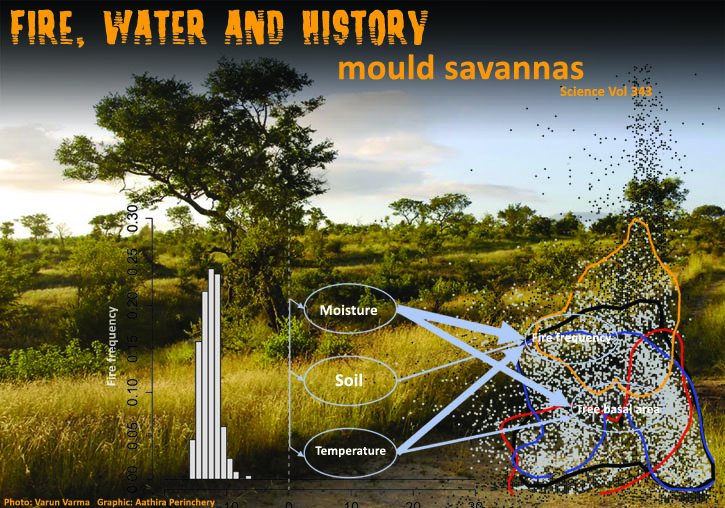Fire, water and history mould tropical savannas
Tree-dotted grasslands epitomize Africa like no other landscape can. What environmental factors maintain similar tropical savannas worldwide? Differing intensities of rain and fire across continents govern the structure of these savannas, according to a recent study published in Science. The study co-authored by NCBS's Mahesh Sankaran and Jayashree Ratnam among others accentuates the role that regional evolutionary and environmental histories play in making each savanna functionally distinct, though structurally similar. The study overrides current perceptions of all tropical savannas being homogeneous, a concept that fields such as climate prediction modeling are currently based on. The work also points to the necessity to preserve these unique wild spaces, many of which are poorly conserved and often mislabelled as wastelands.
The first sight of a savanna can be confusing: would you call it a grassland or a forest? Savannas comprise both grassland and trees. Here, the tree canopies do not come together (unlike in forests), permitting light to filter to the ground. Subsequently, grasses and small plants thrive with woody trees. What maintains this delicate balance of tree and grassland? Studies show that water availability (through seasonal rain), soil nutrients, fire and grazing herbivores define tree cover and consequently, savanna structure. Even savannas separated by continents tend to look structurally similar, prompting scientists to believe that processes regulating vegetation structure within each could be the same. But appearances can be deceptive, for tropical savannas are quite variable. The extent of savannas and their tree cover vary across the tropics. Some have more trees and woody shrubs (also called woody biomass). Savannas with such varying gradients of woody biomass cover exist in Africa, and are home to megafauna including giraffes and wildebeest. The savannas of Australia have fewer herbivores, and some parts are frequently fire-ravaged. The cerrados, as savannas are called in Brazil, account for nearly 21% of the country's land area: some regions are dominated by woody trees, while some are mostly grassy wetlands that remain submerged underwater for a few months every year due to rains. How do the same factors interact with each other to create savannas so distinct, both within and across continents?
To find out, ecologists Caroline Lehmann from the Macquarie University (New South Wales, Australia) and her colleagues including Sankaran and Ratnam from the National Centre for Biological Sciences (NCBS) built a conceptual model incorporating all the factors known to influence woody biomass in savannas. They modeled factors such as resource availability (both water and nutrients), growing conditions (temperature) and disturbances (fire) to discern how these constrain woody biomass. With data collected from a whopping 2154 sites across savannas in Africa, Australia and South America, they used their conceptual model to develop more ecological models and quantify how woody biomass varied with changes in moisture availability (rainfall, its seasonality, and drought), soil properties and temperature.
The scientists found that a common set of environmental factors did shape savannas worldwide. Moisture availability through seasonal rains, fire occurrences and extent of woody biomass define savannas across all three continents. At a finer scale however, these factors interact differently across sites, making every savanna uniquely distinct. Region-specific determinants such as temperature and seasonal rains that drive fire frequency and intensity, and variations in the re-growth and inherent resilience of specific tree species to fires changed across sites. Such site-specific environmental and evolutionary histories drive regional variation between woody vegetation, fire and climate. Using statistical modeling, the scientists prove that it is these environmental and species-specific differences that will determine how each region responds to changing climates in future.
Currently, climate change predictions surrounding savannas employ models that classify all tropical savannas as a single homogeneous ecosystem. Lehmann and her team advise against this generalization. According to their results, changing climates in the three continents could result in these savannas following completely different trajectories in future.
"Savannas of the globe are structurally similar but functionally different," says Ratnam, Senior Fellow with the Ecosystems Group at NCBS. This means that conservation planning and management have to be tailored differently for each region. That is not often the case in most countries. In India too, savannas are generally under-recognized, says Ratnam who has been studying savanna ecology for many years now. Most of what is called thorn and scrub forests are functionally savannas. So are large portions of that are known as dry deciduous forests which are characterized by grassy understories. Many of India's grasslands are shrub-savannas, but classified as wastelands.
To change this, Sankaran, Ratnam and their team at NCBS have been working towards compiling data on Indian savannas since 2010. "We expect the savannas of Asia to be driven by the same fundamental underlying principles as well," says Sankaran, faculty at NCBS. "It will take some time but our goal is to be able to fill the gap in knowledge on Asian savannas and place them in a comparable global context."
To add more global data to their current study which involved more than five years of hard work, the authors hope to also collect genetic and ecological data to compare the phylogenies and functional traits (the physical features of plants which point to their ecological roles) of vegetation across continents. "I am most proud of how we came together as a scientific community and discovered something new by bringing together our perspectives, ideas and data from different regions," says Lehmann. "We now have a more holistic understanding of a biome and that is invaluable."
The cross-continental finding that an ecosystem, while structurally similar is functionally very different, offers a lot of food for thought. "Our results beg the question, could this also be true for the other major biomes of the earth?," asks Ratnam. If future research does indeed confirm this, it could call for a complete revamp in conservation priorities for many ecosystems worldwide.

Comments
Post new comment